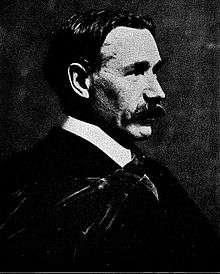Alexander Smith (chemist)
| Alexander Smith | |
|---|---|
 | |
| Born |
September 11, 1865 |
| Died |
September 8, 1922 (aged 56) |
| Residence |
|
| Alma mater |
Edinburgh Collegiate School University of Edinburgh Munich University |
| Spouse(s) | Sarah Bowles (married 1905) |
| Children |
William Bowles Smith Isabella Carter Smith |
| Awards | Keith Medal |
| Scientific career | |
| Fields | Chemistry |
| Institutions |
University of Edinburgh Wabash College University of Chicago Columbia University |
| Signature | |
|
| |
Prof Alexander Smith FRSE LLD (11 September 1865 – 8 September 1922) was a Scottish chemist, who spent his working life teaching in the universities of America.
Biography
He was born at 4 Nelson Street in Edinburgh's New Town,[1] the son of Isabella (née Carter) and Alexander W. Smith, a music teacher. His paternal grandfather was the sculptor Alexander Smith.[2] The family moved to 4 West Castle Road in the Merchiston district while he was young.[3]
He was educated at Edinburgh Collegiate School. He studied sciences (later specialising in chemistry) at the University of Edinburgh. He was taught mathematics by George Chrystal, physics by Peter Guthrie Tait and chemistry by Alexander Crum Brown.[4] He graduated BSc in 1886. During his university years he showed a keen interest in astronomy and published four papers on the subject. He went to Germany in 1886 for further postgraduate studies and gained his doctorate at the University of Munich under Prof Rainer Ludwig Claisen in Baeyer's laboratory in 1889.[5]
In 1890, aged 25, he was elected a Fellow of the Royal Society of Edinburgh. His proposers were Alexander Crum Brown, John Gibson, Leonard Dobbin and Ralph Stockman. In 1911 the Society awarded him its Keith Medal for the period 1909-1911.[6]
After moving to the United States, Smith was Professor of chemistry and mineralogy at Wabash College (1890–94) and later a faculty member at the University of Chicago (1895-1911). His former student James Bert Garner at Wabash College went on to invent the gas mask. In 1911 he was called to Columbia University to be Professor and head of the department of chemistry, and in the same year he held the presidency of the American Chemical Society. He was elected to the National Academy of Sciences in 1915.
In 1919 the University of Edinburgh awarded him an honorary doctorate (LLD).
He retired due to ill-health in 1921 and returned home to Edinburgh, where he died on 8 September 1922.
Family
In 1905 he married Mrs Sarah Ludden, a widow (nee Sarah Bowles) from Memphis, Tennessee.[7] They had one son, William Bowles Smith, and one daughter, Isabella Carter Smith.[8]
Publications
- Asteroids and Their Origin (1885)
- Laboratory Outline of General Chemistry (1899)
- The Teaching of Chemistry and Physics (1902), with Prof. E. H. Hall
- Introduction to General Inorganic Chemistry (1906; second edition, 1912)
- General Chemistry for Colleges (1908; revised edition, 1916)
- A Text-Book of Elementary Chemistry (1914)
References
- ↑ Edinburgh Post Office Directory 1865
- ↑ Noyes, William Albert (1933). "Alexander Smith (1865-1922)". Proceedings of the American Academy of Arts and Sciences. 68 (13): 673–676.
- ↑ Edinburgh Post Office Directory 1875
- ↑ Nature (magazine) obituary 22 Sept 1922
- ↑ "Biographical Index" (PDF). Retrieved 28 November 2014.
- ↑ Biographical Index of Former Fellows of the Royal Society of Edinburgh 1783–2002 (PDF). The Royal Society of Edinburgh. July 2006. ISBN 0 902 198 84 X.
- ↑ http://www.nasonline.org/publications/biographical-memoirs/memoir-pdfs/smith-alexander.pdf
- ↑ Illinois Biographical Dictionary
